Papers by Monica Berrondo

Loop modeling is important in homology modeling, enzyme design, and flexible backbone docking. De... more Loop modeling is important in homology modeling, enzyme design, and flexible backbone docking. Despite improvements in protein structure prediction in general, loop modeling remains very challenging, especially due to the difficulties of sampling diversely while maintaining the loop connectivity. Current approaches in loop modeling often only treat loops up to 8 or 12 residues, and the time required to model these loops is long. In this talk, we will present a new loop modeling algorithm based on a configurational bias approach, similar to that used in polymer modeling, where loops are deleted and then re-grown one residue at the time from both ends, alternating between the N- and C-terminus of the loop. The new algorithm reduces the time required to model loops by as much as five-fold. We found that this approach increases the sampling near the native conformation and therefore we are able to find the native conformation without requiring as much sampling (usually near-native struc...
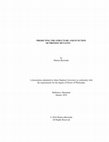
Proteins are essential molecules composed of a linear sequence of amino acids found in all organi... more Proteins are essential molecules composed of a linear sequence of amino acids found in all organisms and participating in many physiological processes. The threedimensional structure a protein adopts, as defined by its unique sequence, determines the biological role of the protein. Knowledge of the three-dimensional structure is vital in understanding how proteins function and this understanding is a crucial step in designing and engineering new proteins with specific functions. The unique sequence of a protein is so important for function, that the mutation of any single amino acid can disrupt the entire fold and thereby function of a protein by upsetting the balance of interacting forces within the protein. Structure based calculations of the relative activity of a protein after a mutation is an important problem since small mutations can lead to complete loss of function of the protein, and subsequently, to disease. However, predicting the functional outcome of mutations is very difficult, even when sufficient structural data are available.
Proteins: Structure, Function, and Bioinformatics, 2011
Methods in enzymology, 2011
We have recently completed a full re-architecturing of the ROSETTA molecular modeling program, ge... more We have recently completed a full re-architecturing of the ROSETTA molecular modeling program, generalizing and expanding its existing functionality. The new architecture enables the rapid prototyping of novel protocols by providing easy-to-use interfaces to powerful tools for molecular modeling. The source code of this rearchitecturing has been released as ROSETTA3 and is freely available for academic use. At the time of its release, it contained 470,000 lines of code. Counting currently unpublished protocols at the time of this writing, the source includes 1,285,000 lines. Its rapid growth is a testament to its ease of use. This chapter describes the requirements for our new architecture, justifies the design decisions, sketches out central classes, and highlights a few of the common tasks that the new software can perform.
Proteins: Structure, Function, and Bioinformatics, 2010
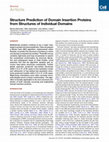
Structure, 2008
Multidomain proteins continue to be a major challenge in protein structure prediction. Here we pr... more Multidomain proteins continue to be a major challenge in protein structure prediction. Here we present a Monte Carlo (MC) algorithm, implemented within Rosetta, to predict the structure of proteins in which one domain is inserted into another. Three MC moves combine rigid-body and loop movements to search the constrained conformation by structure disruption and subsequent repair of chain breaks. Local searches find that the algorithm samples and recovers near-native structures consistently. Further global searches produced top-ranked structures within 5 Å in 31 of 50 cases in low-resolution mode, and refinement of top-ranked low-resolution structures produced models within 2 Å in 21 of 50 cases. Rigid-body orientations were often correctly recovered despite errors in linker conformation. The algorithm is broadly applicable to de novo structure prediction of both naturally occurring and engineered domain insertion proteins.
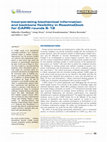
Proteins: Structure, Function, and Bioinformatics, 2007
In CAPRI rounds 6-12, RosettaDock successfully predicted 2 of 5 unboundunbound targets to medium ... more In CAPRI rounds 6-12, RosettaDock successfully predicted 2 of 5 unboundunbound targets to medium accuracy. Improvement over the previous method was achieved with computational mutagenesis to select decoys that match the energetics of experimentally determined hot spots. In the case of Target 21, Orc1/ Sir1, this resulted in a successful docking prediction where RosettaDock alone or with simple site constraints failed. Experimental information also helped limit the interacting region of TolB/Pal, producing a successful prediction of Target 26. In addition, we docked multiple loop conformations for Target 20, and we developed a novel flexible docking algorithm to simultaneously optimize backbone conformation and rigid-body orientation to generate a wide diversity of conformations for Target 24. Continued challenges included docking of homology targets that differ substantially from their template (sequence identity <50%) and accounting for large conformational changes upon binding. Despite a larger number of unbound-unbound and homology model binding targets, Rounds 6-12 reinforced that RosettaDock is a powerful algorithm for predicting bound complex structures, especially when combined with experimental data. Proteins 2007; 69:793-800. V V C 2007 Wiley-Liss, Inc.
Journal of Physics: Condensed Matter, 2004
Crozier et al (2001 Biophys. J.81 3077) have simulated an electrically neutral but polar model ch... more Crozier et al (2001 Biophys. J.81 3077) have simulated an electrically neutral but polar model channel under an applied field and found that there was a current of positive Na+ ions but there was no current of negative Cl− ions unless the concentration was high or a very large field was applied. They suggested that this asymmetry in an electrically
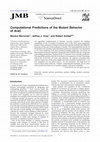
Journal of Molecular Biology, 2010
An algorithm implemented in Rosetta correctly predicts the folding capabilities of the 17-residue... more An algorithm implemented in Rosetta correctly predicts the folding capabilities of the 17-residue N-terminal arm of the AraC gene regulatory protein when arabinose is bound to the protein and the dramatically different structure of this arm when arabinose is absent. The transcriptional activity of 43 mutant AraC proteins with alterations in the arm sequences was measured in vivo and compared with their predicted folding properties. Seventeen of the mutants possessed regulatory properties that could be directly compared with folding predictions. Sixteen of the 17 mutants were correctly predicted. The algorithm predicts that the N-terminal arm sequences of AraC homologs fold to the Escherichia coli AraC arm structure. In contrast, it predicts that random sequences of the same length and many partially randomized E. coli arm sequences do not fold to the E. coli arm structure. The high level of success shows that relatively "simple" computational methods can in some cases predict the behavior of mutant proteins with good reliability.
Chemistry & Biology, 2012
Mutation of surface residues to charged amino acids increases resistance to aggregation and can e... more Mutation of surface residues to charged amino acids increases resistance to aggregation and can enable reversible unfolding. We have developed a protocol using the Rosetta computational design package that ''supercharges'' proteins while considering the energetic implications of each mutation. Using a homology model, a single-chain variable fragment antibody was designed that has a markedly enhanced resistance to thermal inactivation and displays an unanticipated z30-fold improvement in affinity. Such supercharged antibodies should prove useful for assays in resource-limited settings and for developing reagents with improved shelf lives.
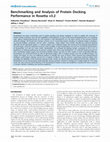
PloS one, 2011
RosettaDock has been increasingly used in protein docking and design strategies in order to predi... more RosettaDock has been increasingly used in protein docking and design strategies in order to predict the structure of protein-protein interfaces. Here we test capabilities of RosettaDock 3.2, part of the newly developed Rosetta v3.2 modeling suite, against Docking Benchmark 3.0, and compare it with RosettaDock v2.3, the latest version of the previous Rosetta software package. The benchmark contains a diverse set of 116 docking targets including 22 antibody-antigen complexes, 33 enzyme-inhibitor complexes, and 60 'other' complexes. These targets were further classified by expected docking difficulty into 84 rigid-body targets, 17 medium targets, and 14 difficult targets. We carried out local docking perturbations for each target, using the unbound structures when available, in both RosettaDock v2.3 and v3.2. Overall the performances of RosettaDock v2.3 and v3.2 were similar. RosettaDock v3.2 achieved 56 docking funnels, compared to 49 in v2.3. A breakdown of docking performa...
Uploads
Papers by Monica Berrondo